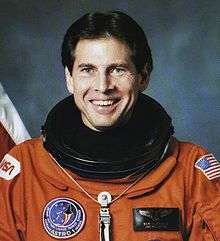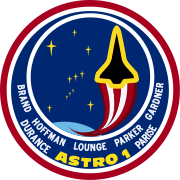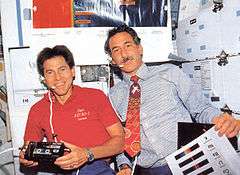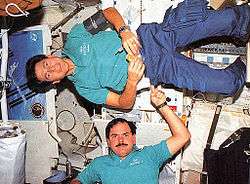Samuel T. Durrance
Samuel Thornton Durrance (Ph.D.) is an American scientist who flew aboard two NASA Space Shuttle missions as a payload specialist.
Samuel Thornton Durrance | |
|---|---|
 | |
| Born | September 17, 1943 (age 76) |
| Nationality | American |
| Occupation | Physicist |
| Space career | |
| JHU Payload Specialist | |
Time in space | 25d 14h 13min |
| Missions | STS-35, STS-67 |
Mission insignia |   |
Background
Durrance was born September 17, 1943, in Tallahassee, Florida, but considers Tampa, Florida his hometown. He received a Bachelor of Science degree and a Master of Science degree in physics (with honors), at California State University, Los Angeles (Cal State LA), 1972 and 1974, respectively, and a Doctor of Philosophy degree in astro-geophysics at the University of Colorado at Boulder, 1980. In 2000, he was awarded a Honorary Doctor of Science from the University of Colorado at Boulder along with eight other astronaut alums.
Durrance was a Principal Research Scientist in the Department of Physics and Astronomy at Johns Hopkins University, Baltimore, Maryland. He was a co-investigator for the Hopkins Ultraviolet Telescope, one of the instruments of the Astro Observatory.
Starting in 2000, he was the executive director of the Florida Space Research Institute which was located at the NASA Kennedy Space Center.
He now resides in Melbourne, Florida and is a professor of Physics and Space Sciences at Florida Institute of Technology.
He is a member of the American Astronomical Society, American Geophysical Union, International Astronomical Union, Association of Space Explorers, Planetary Society, and Phi Kappa Phi.
Academic career

Durrance has been involved in the flight hardware development, optical and mechanical design, construction, and integration of the Hopkins Ultraviolet Telescope and the Astro Observatory. He has conducted research and directed graduate students at the Johns Hopkins University for the past 15 years. He has designed and built spectrometers, detectors, and imaging systems, and made numerous spacecraft and ground-based astronomical observations. He conceived and directed a program at Johns Hopkins University to develop adaptive-optics instrumentation for ground based astronomy. He led the team that designed and constructed the Adaptive Optics Coronagraph, which led to the discovery of the first cool brown dwarf orbiting a nearby star. He also a co-discoverer of changes in the planet-forming disk surrounding the star beta Pictoris.
His research interests include the origin and evolution of the solar system, the search for planets around other stars, planetary astronomy, atmospheric physics, nuclear physics, adaptive optics, spacecraft operations, and the origin of life. He has published over 60 technical papers in professional journals covering these topics.
Durrance logged over 615 hours in space as a payload specialist and member of the crew of Space Shuttle Columbia for the STS-35/Astro-1 and Space Shuttle Endeavour for the STS-67/Astro-2 missions.
Current Assignment (2006)

Durrance is currently employed by the Florida Institute of Technology in Melbourne, Florida, serving as a professor in the Department of Aerospace, Physics and Space Sciences.[1]